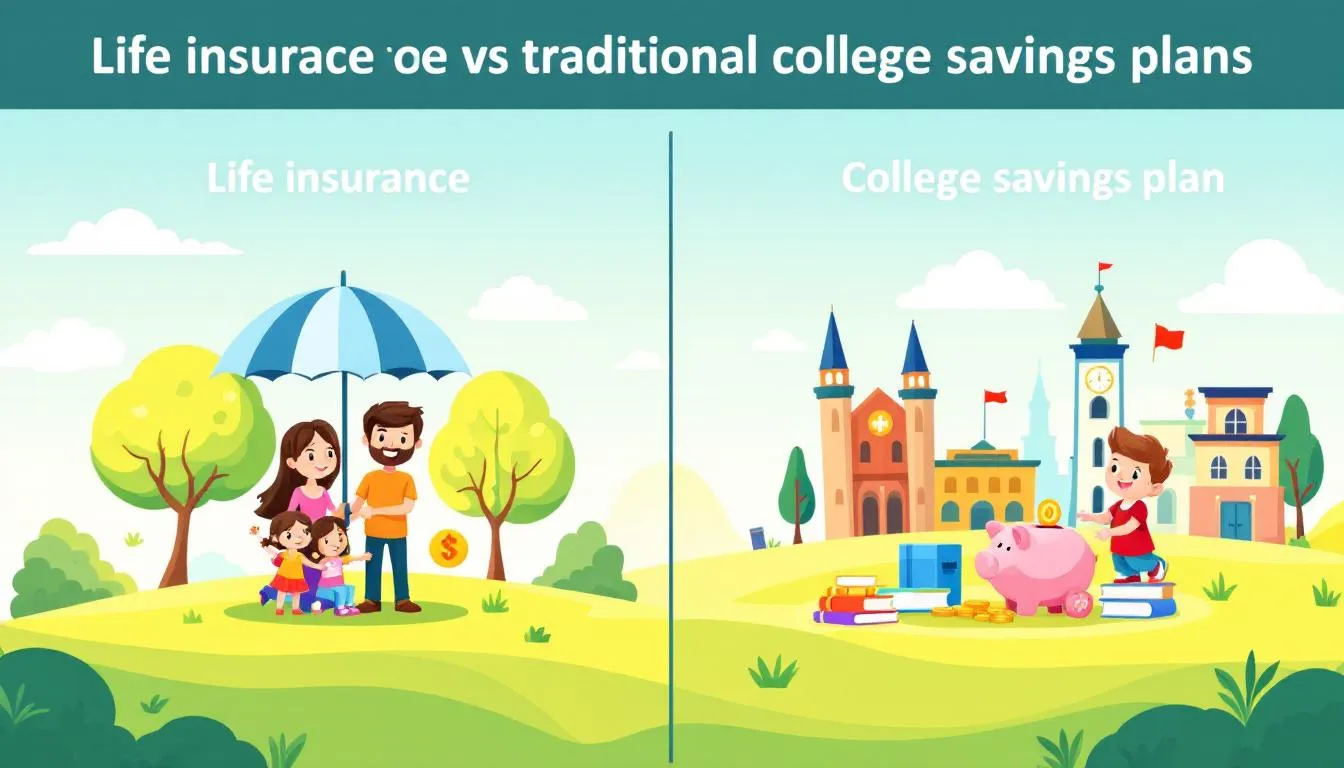Thinking about how life insurance can help cover college costs for your kids? You’re not alone. Life insurance, especially whole life policies, can build cash value over time that you can tap into for tuition. It’s a flexible savings tool beyond its primary role of financial protection. In this article, we’ll break down how it works, compare it to traditional savings plans, and highlight its tax advantages.
Key Takeaways
- Life insurance, particularly whole life insurance, can serve as both a savings tool and a protective measure for covering college expenses, allowing for cash value accumulation that is generally exempt from financial aid calculations.
- Unlike 529 plans, life insurance policies offer flexibility in fund usage, allowing families to access cash value for a variety of expenses and without incurring tax penalties for non-educational withdrawals.
- Strategic planning, including consulting with financial professionals and starting life insurance policies early, is crucial for maximizing benefits and ensuring sufficient funds for both college costs and long-term family financial security.
Understanding Life Insurance for College Funding

Using life insurance for college funding might seem unconventional, but it offers a host of benefits that can make it a smart financial move. A life insurance policy not only provides protection against unforeseen events but also serves as a versatile savings tool. Permanent life insurance, especially whole life insurance, allows for cash value accumulation, which can be leveraged to cover education costs.
Life insurance policies offer flexibility in terms of beneficiaries, which means the funds can be used to support multiple generations. This makes life insurance a valuable financial instrument for families looking to ensure financial stability and educational opportunities for their children.
Understanding the different types of life insurance and their effective utilization can help determine the best approach when exploring this college funding strategy.
Whole Life Insurance Benefits
Whole life insurance stands out as a robust option for college funding due to its cash value growth and lifelong protection. Unlike term life insurance, whole life insurance policies combine a death benefit with a growing cash value, which can serve as a savings tool for educational expenses. This dual benefit ensures that your investment not only provides financial security but also grows over time, offering a reliable source of funds when college tuition bills arrive.
A significant advantage of whole life insurance policies is that the cash value is generally not counted as an asset when assessing financial aid. This means that it can help in securing more financial aid for your child while also providing a lasting financial legacy that supports their educational goals.
Strategic planning with whole life insurance creates a financial safety net that supports your heirs and their educational needs.
Term Life Insurance for College Costs
Term life insurance can also play a role in covering college costs, although it functions differently from whole life insurance. Term life insurance policies provide a death benefit for a specified period, which can be used to cover education expenses should the unexpected occur. While it does not accumulate cash value, the death benefit can be a vital resource for ensuring that your child’s college tuition is paid for without incurring additional financial burdens.
The main difference between term and whole life insurance is that term policies lack a savings component. While term life insurance offers essential financial protection, it does not provide the long-term cash value growth seen in whole life insurance.
Nonetheless, term life insurance remains a valuable tool for families seeking affordable coverage to protect against the risk of losing income needed for education costs, including the possibility of accidental death.
Building Cash Value for College Expenses

One of the standout features of permanent life insurance, such as whole life insurance, is its ability to accumulate cash value over time. This cash value can be a crucial resource for funding college expenses. Unlike traditional savings plans, the cash value in a whole life insurance policy grows steadily and can be accessed when needed, providing both a savings vehicle and insurance protection.
The accumulated cash value can be used to pay for various education costs, from tuition to books and housing, offering financial support when it’s most needed. Leveraging the cash value component of your life insurance policy can ensure funds are available for college expenses without the volatility associated with market-dependent savings plans and a cash value account.
How Cash Value Grows Tax Deferred
A significant benefit of whole life insurance is that the cash value grows on a tax-deferred basis. This means that the growth of your policy’s cash value does not incur taxes until the funds are accessed, allowing for more efficient accumulation of savings. The tax-deferred nature of cash value growth is especially advantageous for families saving for college, as it enables the funds to grow without immediate tax implications, maximizing the amount available for education costs.
The ability to grow cash value to grow tax deferred ensures that the savings component of your life insurance policy can accumulate more effectively. When it comes time to use these funds for college expenses, the policyholder can potentially access them without paying taxes, provided certain conditions are met.
This tax advantage can significantly enhance the overall benefit of using life insurance as a college funding strategy.
Accessing Cash Value for College Tuition
When it comes to paying for college, accessing the policy’s cash in your life insurance policy can be done through policy loans or direct withdrawals. Loans against your policy’s cash value are a popular method because they do not incur taxes as long as the policy remains active. Withdrawals can also be tax-free if they do not exceed the total premiums paid into the policy. These options provide flexible financial support for a variety of college-related expenses, from tuition and housing to books and other essential costs.
The flexibility of using cash value for educational expenses means that policyholders can tailor their approach to meet their specific needs. Whether you’re covering tuition, room and board, or other qualified education expenses, the funds from your life insurance policy can be accessed without the penalties often associated with other expenses savings plans.
This makes life insurance a versatile and effective tool for ensuring your child’s college funding needs are met.
Comparing Life Insurance to Traditional College Savings Plans

Life insurance offers unique advantages compared to traditional college savings plans like 529 plans:
- Flexibility in how the funds can be used
- 529 plans are restricted to qualified education expenses
- Life insurance policies allow for broader use of the accumulated funds, making them a more versatile option for families
In addition to flexibility, permanent life insurance policies provide a tax-deferred savings component, which can be a valuable alternative to traditional college savings vehicles. However, it’s important to note that life insurance policies often come with higher fees compared to 529 plans, making permanent insurance a consideration for some.
Despite this, the ability to use the funds without affecting federal student loan debt eligibility makes life insurance an attractive option for many families.
Flexibility of Life Insurance vs. 529 Plans
The flexibility of using life insurance for college savings is one of its most compelling features. Unlike 529 plans, which are limited to covering educational costs, life insurance funds can be used for a variety of expenses, providing families with more options. This flexibility ensures that if your child decides not to attend college, the funds can still be utilized for other financial goals without penalties.
In contrast, 529 plans restrict the use of funds to qualified education expenses, which can limit their utility. This restriction can be a drawback for families who need more adaptable savings options. By using life insurance, you can ensure that your savings are available for a broader range of needs, providing greater financial security and flexibility.
Impact on Financial Aid Eligibility
When planning for college costs, understanding the impact on financial aid eligibility is crucial. Traditional savings plans like 529 accounts can affect financial aid calculations, with up to 5.64% of parental assets being factored into the aid formula. This can reduce the amount of financial aid your child is eligible to receive, increasing the financial burden on the family.
Life insurance, on the other hand, does not typically impact financial aid eligibility. The cash value accumulated in a life insurance policy is generally not considered an asset in financial aid calculations, allowing families to maximize their aid eligibility while still providing a robust savings tool for college expenses.
This advantage makes life insurance an attractive option for families looking to balance college funding with financial aid considerations.
Strategic Planning with Life Insurance

Effective planning is essential when using life insurance for college funding. Starting early and consulting with a financial professional allows families to develop a comprehensive strategy that maximizes the benefits of their life insurance policy. This approach not only provides a financial cushion for college expenses but also ensures long-term security for the family.
Strategic planning involves understanding the nuances of different life insurance policies and how they align with your financial goals. Whether you choose whole life insurance for its cash value growth or term life insurance for its affordability, having a well-thought-out plan can make a significant difference in achieving your college funding objectives.
Starting Early with Whole Life Insurance
Starting early with whole life insurance is crucial for maximizing its benefits:
- Purchasing a whole life insurance policy when your children are young allows the cash value to grow over a longer period.
- This growth significantly aids in covering future college expenses.
- The longer the policy is in force, the more cash value it accumulates.
- This accumulated cash value provides a substantial financial resource when it’s time to pay for college.
Starting early not only promotes cash value growth but also locks in lower premiums and secures lifelong coverage for your family. This proactive approach to college funding not only helps in preparing for education costs but also contributes to the overall financial security of your family.
Consulting a Financial Professional
Consulting a financial professional can provide valuable insights into how life insurance can be strategically used to cover college costs. These experts can help navigate the complexities of life insurance policies, ensuring that your strategy aligns with your financial goals and college funding needs. With their guidance, you can tailor your life insurance plan to maximize benefits and minimize potential pitfalls.
A financial professional can also help you understand the tax implications and other financial considerations of using life insurance for college expenses. Working with a tax professional helps develop a comprehensive plan that ensures financial security for covering college tuition and related expenses, providing peace of mind about your child’s education.
Tax Advantages of Using Life Insurance for College Costs

One of the most compelling reasons to use life insurance for college funding is the tax advantages it offers. Life insurance policies allow for tax-free withdrawals and loans against the policy’s cash value if managed correctly. This flexibility can make a significant difference in how much money is available to cover college expenses and other financial goals.
Unlike traditional savings plans, where non-educational withdrawals can incur significant penalties, life insurance provides a more adaptable and tax-efficient way to save for college. By understanding these tax advantages and planning accordingly, you can ensure that your life insurance policy serves as an effective tool in your college funding strategy.
Tax-Free Withdrawals and Loans
Funds borrowed from a life insurance policy are typically not considered taxable income, provided the loan amount does not exceed the total premium payments made. Key points include:
- Policyholders can access the cash value of their policy to cover college expenses without incurring taxes.
- This offers significant flexibility compared to traditional 529 plans.
- Withdrawals from the cash value can also be tax-free if they do not surpass the total premiums paid into the policy.
Using a life insurance policy for college expenses provides a unique advantage, as it does not impact financial aid eligibility. This allows families to maximize their financial aid while still utilizing the funds from their life insurance policy for a variety of needs, ensuring that the funds are available when most needed.
Avoiding Tax Penalties
One significant drawback of traditional savings plans like 529 accounts is the potential for tax penalties if the funds are used for non-qualified expenses:
- A withdrawal of money from a 529 account for purposes other than education incurs income taxes.
- There is also a 10% penalty on such withdrawals.
- These penalties can significantly reduce the available funds.
This limitation can be a considerable cost disadvantage for families needing more money flexibility in their savings amid market volatility, subject to various economic factors.
In contrast, the cash value of a whole life insurance policy can be utilized without these penalties, even if your child receives a full scholarship and the funds are no longer needed for college expenses. This flexibility allows families to repurpose their savings for other financial goals without the risk of incurring tax penalties, providing a more adaptable and efficient savings strategy.
Creating a Legacy with Life Insurance
Life insurance serves as a crucial tool for establishing a financial legacy that ensures your family’s protection and security. By combining the benefits of protection and savings, life insurance can help support future generations, providing them with financial stability and opportunities. This dual-purpose nature of life insurance makes it an invaluable asset in long-term financial planning.
A well-structured life insurance policy not only covers college costs but also facilitates the transfer of wealth to your heirs, ensuring that they have the resources they need to succeed. This approach helps maintain the financial security of your family across generations, reinforcing the importance of strategic planning and thoughtful financial management.
Dual Benefits: Protection and Savings
Life insurance serves a dual purpose: it provides a death benefit for beneficiaries while also offering a savings vehicle through its cash value component. In the unfortunate event of the policyholder’s death, life insurance guarantees a death benefit that ensures college costs can still be covered. This dual benefit offers families peace of mind knowing that their child’s education will be financially supported regardless of life’s uncertainties.
The cash value in permanent life insurance policies grows over time, providing a financial resource that can be accessed to fund education costs. Various methods, such as policy loans or withdrawals, enable parents to use the cash value for college tuition and other related expenses. The tax-deferred growth of the cash value further enhances its utility, allowing families to maximize their savings for educational purposes.
Supporting Future Generations
A well-structured life insurance policy can ensure that funds are available for future generations, helping to maintain their financial security and financial strength. By strategically designing your life insurance policy, you can facilitate the transfer of wealth, ensuring that your children and grandchildren have the financial resources they need to pursue their educational and personal goals.
This long-term approach to financial planning not only supports your child’s education but also provides a foundation for your family’s financial stability. By prioritizing both protection and savings, life insurance can be a powerful tool in creating a lasting legacy that benefits your child’s future education, reinforcing the importance of thoughtful financial planning.
Summary
Using life insurance to cover college costs offers a unique and flexible approach to financial planning. From building cash value to leveraging tax advantages and consulting financial professionals, life insurance provides a comprehensive solution for education funding. The dual benefits of protection and savings make it an invaluable tool for ensuring your child’s educational future while also creating a lasting financial legacy.
As you consider your options for college funding, remember the versatility and benefits that life insurance offers. By strategically planning and starting early, you can maximize the potential of your life insurance policy to provide financial security and support for your child’s education. Embrace this innovative approach to college funding and secure a brighter future for your family.
Frequently Asked Questions
How does life insurance help in covering college costs?
Life insurance can assist in covering college costs by building cash value that you can borrow against or withdraw to finance educational expenses. This provides a financial resource that can support your child’s educational journey.
What is the difference between whole life insurance and term life insurance for college funding?
Whole life insurance is ideal for college funding as it builds cash value and offers lifetime coverage, while term life insurance offers protection only for a set period without cash accumulation. This makes whole life insurance a more stable long-term option for funding education.
Can I use life insurance funds for non-educational expenses?
Yes, you can use life insurance funds for non-educational expenses without incurring taxes or penalties, provided specific conditions are met. This flexibility makes life insurance a valuable financial tool.
How does life insurance affect financial aid eligibility?
Life insurance does not affect financial aid eligibility, as it is not considered when calculating assets for financial aid, unlike 529 plans.
Why should I consult a financial professional for using life insurance for college costs?
Consulting a financial professional is crucial for effectively navigating the complexities of life insurance and tailoring a strategy that aligns with your financial goals for college funding. This expert guidance can help you make informed decisions that maximize your benefits.
